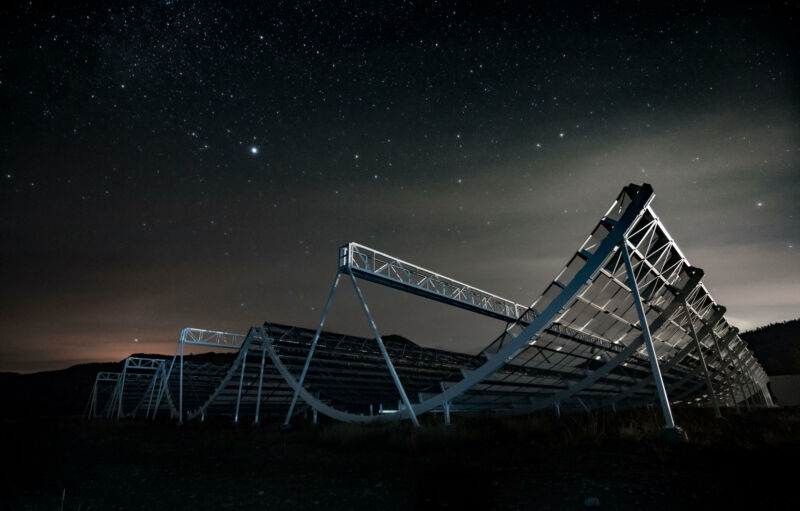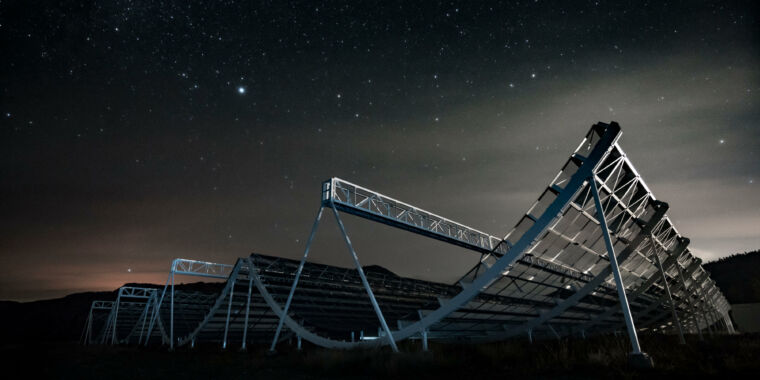
Today, researchers are announcing they’ve solved one of the questions that has been nagging them over the past decade: what exactly produces the weird phenomena known as fast radio bursts (FRBs)? As their name implies, FRBs involve a sudden blast of radio-frequency radiation that lasts just a few microseconds. We didn’t even know that FRBs existed until 2007 but have since cataloged hundreds of them; some come from sources that repeatedly emit them, while others seem to burst once and go silent.
Obviously, you can produce this sort of sudden surge of energy by destroying something. But the existence of repeating sources suggests that at least some of them are produced by an object that survives the event. That has led to a focus on compact objects, like neutron stars and black holes, with a class of neutron stars called magnetars being viewed very suspiciously.
Those suspicions have now been borne out, as astronomers have watched a magnetar in our own galaxy sending out an FRB at the same time it emitted pulses of high-energy gamma rays. This doesn’t answer all our questions, as we’re still not sure how the FRBs are produced or why only some of the gamma-ray outbursts from this magnetar are associated with FRBs. But the confirmation will give us a chance to look more carefully at the extreme physics of magnetars as we try to understand what’s going on.
“Magnetar” is not the latest superhero film
Magnetars are an extreme form of a neutron star, a type of body that is already notable for being extreme. They are the collapsed core of a massive star, so dense that atoms get squeezed out of existence, leaving a swirling mass of neutrons and protons. That mass is roughly equal to the Sun’s but compressed into a sphere with a radius of about 10 kilometers. Neutron stars are best known for powering pulsars, rapidly repeating bursts of radiation driven by the fact that these massive objects can complete a rotation in a handful of milliseconds.
Magnetars are a different type of extreme. They tend not to rotate as quickly but have intense magnetic fields. We don’t know, however, whether those fields are inherited from a very magnetic parent star or generated by superconducting material sloshing around inside the neutron star. Whatever the source, they’re about a trillion times stronger than the Earth’s magnetic field. That’s strong enough to distort the electron orbitals in atoms, effectively eliminating chemistry for any normal matter that somehow gets close to a magnetar. While the period of high magnetic fields only lasts a few thousand years before the fields dissipate, there are enough neutron stars to keep a regular supply of magnetars around.
Their magnetic fields can power highly energetic events, either by accelerating particles or through magnetic disturbances driven by material shifting within the neutron star. As a result, magnetars have been identified by their semi-regular production of high-energy X-rays and low-energy gamma rays, giving them the name “soft gamma-ray repeaters,” or SGR. Several of them have been identified within the Milky Way, including SGR 1935+2154.
In late April of this year, SGR 1935+2154 entered an active phase, sending out a number of pulses of high-energy photons that were picked up by the Swift observatory, in orbit around Earth. That was completely normal. What wasn’t normal is that a number of radio observatories picked up an FRB at precisely the same time.
STARE and a CHIME
The Canadian Hydrogen Intensity Mapping Experiment, or CHIME, is a large array of radio antennas that was originally designed for other reasons but has turned out to be great for spotting FRBs, since it can constantly observe a large stripe of the sky. SGR 1935+2154 was at the edge of its field of view, meaning there were some uncertainties in its identity of the source, but the results were clearly consistent with an association between the FRB and the gamma ray output.
And CHIME wasn’t the only thing watching. The Survey for Transient Astronomical Radio Emission 2 (STARE2) was also able to pick up the same event, although its team only noticed it after finding out that Swift had observed an active magnetar. So, it’s clear that the FRB’s production was in some way associated with the gamma-ray output from SGR 1935+2154.
But what was notable was that both CHIME and STARE2 were able to observe other gamma-ray outbursts from SGR 1935+2154, and they didn’t see any FRBs. CHIME notes that it had the opportunity to observe four outbursts from the magnetar in late 2019 but had seen nothing from it. In fact, the set of papers being released today includes one entirely dedicated to the lack of observations made by FAST (the Five-hundred-meter Aperture Spherical radio Telescope, a giant dish in China). This was despite the fact that FAST had been intentionally monitoring SGR 1935+2154 for eight hours in April but didn’t happen to be pointing at it when the FRB was observed—even though some of those observations occurred during outbursts of high-energy radiation.
Joules, ergs, and megatons
These clearly indicate that one of two things is happening. Either an FRB requires a set of conditions that are only rarely present during the production of outbursts, or FRBs are actually beamed away from the source, rather than a burst that radiates in all directions. In the latter case, we would just be seeing the ones that, by chance, are oriented toward Earth. We have detected radio emissions from magnetars in our galaxy previously, but those have all been considerably less powerful.
There’s also the question of whether this was really an FRB of the type we’ve been detecting all along. Based on its properties and those of other astronomical phenomena, the STARE2 team finds the event is obviously closest to FRBs. But it’s not quite in the cluster with them, largely because of its energy. The teams calculate that the event released about 1034 ergs (1027 joules, or 1011 megatons). Typical FRBs start out 100 times more powerful than that and go up considerably from there, maxing out at over 1043 ergs.
While this is clearly compelling and likely to be a big step in understanding FRBs, there’s just enough uncertainty to keep astrophysicists arguing for a while longer. Still, the fact that a magnetar can produce something that looks so much like an FRB is likely to have a major influence on thinking.
How’d that happen?
So, why should gamma-ray outbursts be associated with FRBs at all? Since magnetars have been the object of suspicious glances for nearly as long as we’ve known about FRBs, there’s actually a fair bit of theoretical modeling of how they might produce an FRB.
These models are informed in part by the burst’s properties. We know they’re common enough that they can’t be produced in an event that destroys its source, something confirmed by the discovery of repeaters. They’re also informed by the properties of known objects, ranging from pulsars to the gamma-ray bursts produced by the destruction of stars.
These models are variations on three basic configurations. One assumes that the magnetic fields organize the plasma near the magnetar in a way that forms the radio equivalent of a laser, amplifying their energy before it’s radiated out. An alternative is that the fields accelerate charged particles in the plasma and emit radiation when changes in the magnetic field cause these particles to shift directions suddenly. The final alternative is a relativistic shock, which could occur if the magnetar burped out some material that was accelerated by the magnetic fields to extremely high speeds, then ran into the plasma near the object, with the ensuing shock causing the FRB.
Right now, the only way to figure out what’s going on is to get more observations. The observatories that captured this FRB will undoubtedly continue to spot those coming from outside the galaxy, which might be critical in determining whether all of these events are produced by a single mechanism. But really understanding that mechanism will probably require closer observations of the 30 or so magnetars that we know about in the Milky Way. And that may not require seeing another locally grown FRB; getting a better feel for what’s behind their gamma-ray outbursts could help determine how those events could also produce radio bursts.
Nature, 2020. Four articles accessible from this news story.
